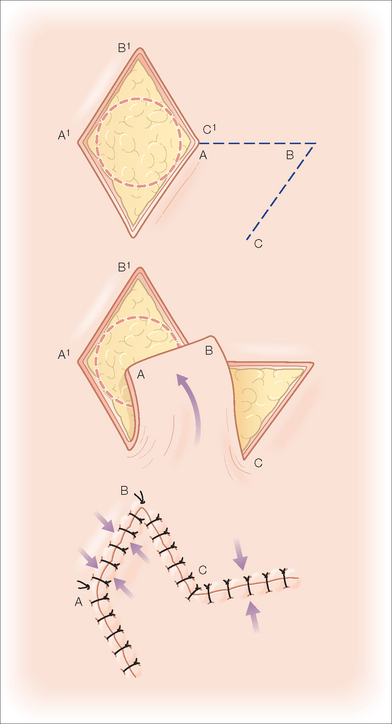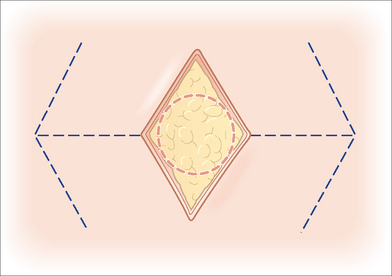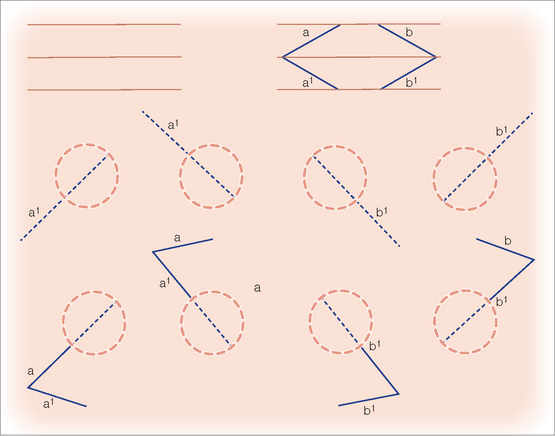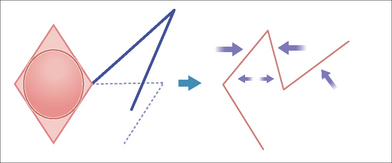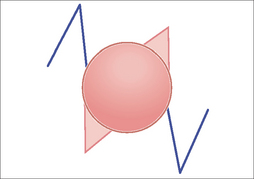Chapter 7 Transposition Flaps
RHOMBIC FLAPS
Design
The classic rhombic flap was first described by Limberg in 19631 and was designed to create a secondary defect perpendicular to the primary defect that, when closed, would not only provide tissue to close the primary defect, but would also redirect the tension vector 90°.2 This traditional flap design allows the primary defect to be closed under almost no wound tension.3 Subsequent design modifications by DuFourmental and Webster enabled more tension sharing between the primary and secondary defects because the angles and sizes of the flaps’ primary lobes were reduced.4
In planning a classic Limberg rhombic flap, the surgeon converts the primary defect into a four-sided parallelogram with each side of equal length and tip angles equal to 60° and 120°.5 This basic shape, the rhombus, forms the recipient site for the flap as well as the template upon which the required incisions are planned. In this classic design (Figure 7.1), the flap’s incision lines are drawn by extending a line (line AB) outward from one of the obtuse tips for a length equal to that of one side of the rhombus. From the free end of the extending line (line AB), a second line (line BC) is drawn parallel to and equal in length to one of the near sides of the rhombus. The tip angle of the flap’s primary lobe in this configuration is 60°. The incised flap is then lifted and transposed into place. The vector of maximal wound closure tension is thus redirected from that of closing the primary defect to that of closing the new secondary defect created in the execution of the flap. This allows for an effective 90° redirection of the tension vector.
Though the classic rhombic transposition flap can be designed and executed off of the long axis of the rhombus, there are two advantages to designing it off of the short axis of the defect.6 First, this design keeps the flap as small as possible while filling the primary defect completely. Second, the design also minimizes the arc through which the flap must rotate to reach the defect.7,8 There are four possible flap designs off of the short axis for any rhombic defect (Figure 7.2). Which of these four flap configurations is chosen by the surgeon depends on several factors that affect the final outcome. These factors include the adjacent anatomic structures, the adjacent skin type, and where the resulting scar line will be best hidden.
Extrapolation of Rhombic Flap Principles to Round Defects
Most defects encountered in dermatologic surgery are not rhombic in shape. Rather, defects resulting from extirpation of tumors are generally round because of the radial growth patterns of most tumors. The principles described for repair of rhombic defects may also be used to reconstruct circular defects. In fact, applying these principles to a round defect affords even greater flexibility in transposition flap design and orientation.8 A rhombic design can be drawn around the round defect in a favorable orientation, keeping in mind the optimal flexibility of the surrounding tissue and adjacent anatomic structures (Figure 7.3). The optimal placement of the flap’s closure lines can also be planned according to the adjacent relaxed skin tension or cosmetic unit junction lines. Since the majority of the wound closure tension is placed on the closure of the secondary defect, the secondary defect’s closure is usually designed to be aligned with the relaxed skin tension lines.
When designing the flap from a circular defect, the length of the line extending from the defect should be designed longer than the diameter of the circular wound because this diameter is actually shorter than the short axis of the rhombus that could be drawn around the circular defect (Figure 7.1). After the initial line is drawn extending from the circular wound, a second line of the same length is drawn to meet this initial line, keeping a tip angle of 60° or less to complete the flap. The tissue redundancy at the base of the primary defect created by the rotation of the transposition flap is removed with trimming of a triangle in the area of the flap’s pivot point. The tip of the transposed tissue may be rounded to fit the circular defect, or the defect may be squared off to accommodate the angular flap. This choice can be made based upon which option is likely to yield the optimal aesthetic result.
A thorough understanding of the forces of wound closure tension is essential to the planning, execution, and outcome of any closure. The primary tension component of a classic rhombic flap occurs with the closure of the secondary defect. A second set of tension forces is generated at the tip of the flap when it is moved into the primary defect. These forces are due to resistance to movement at the flap pedicle as well as effective shortening of the length of the flap during the rotation into the recipient site. Dzubow has described these forces as pivotal restraint.9 Securing the flap tip to the far end of the recipient site under inappropriately high tension can lead to tip ischemia and necrosis. There are two modifications of flap design that can be used in certain situations to minimize the shortening of the flap and reduce or eliminate the potential tension at the flap tip.
When the leading edge and the secondary limb of the flap’s primary lobe are extended/lengthened, the flap is slightly enlarged (Figure 7.4). This lengthening can compensate for the inevitable shortening that results from pivotal restraint at the flap’s base. Lengthening the flap by this method will help to ensure that flap rests in the primary defect without undue tension at its tip.
An alternate method to lengthen the flap and minimize tip tension at closure is to design the flap with a slightly more obtuse angle (greater than 120°) at the flap’s origination point (Figure 7.5). This design decreases the degree of rotation necessary during flap execution and subsequently reduces pivotal restraint. Wide undermining around the flap also assists in the redistribution of tension vectors and contractile forces during the healing phase.
Modified Rhombic Flaps
DuFourmental Flap
This modification of the classic rhombic transposition flap narrows the angle of the tip of the secondary defect and creates a shorter arc of rotation for the flap. This allows easier closure of the secondary defect and some sharing of the tension between the primary and secondary defects. As in the classic rhombic flap, the DuFourmental variant of the rhombic flap is designed by extending the first line from the short axis of the rhombic defect (Figure 7.6). However, the angle at which the first line is extended from the rhombus differs from the classic rhombic flap in that it bisects the angle formed by the first line of the classic rhombic flap (which extends straight from the short axis of the rhomboid defect) and the line formed by extending one of the sides of the rhomboid from the same corner. The length of the first line is equal to that of a side length of the rhomboid. The second line originates from the free end of the first line, and is drawn parallel to the long axis of the rhomboid. This second line’s orientation results in a slightly widened pedicle base, a decrease in the tip volume of the flap, a decrease in the amount of movement necessary to execute the flap, and the introduction of some degree of tissue advancement along the long axis of the rhomboid defect. In most cases, a tissue redundancy at the base of the leading edge of the flap is generated; this should be removed by excising a slightly larger “dog-ear” at the base of the flap.
Webster 30° Angle Flap
The Webster modification of the rhombic transposition flap makes the angle of the flap even more acute than the DuFourmental variant and allows for even greater tension sharing between the primary and secondary defects.10 A Webster 30° angle flap is planned similarly to the DuFourmental flap, with the exception that the distal tip of the flap is designed to have an angle of 30° (Figure 7.7). This more acute angle produces a slimmer design and narrower pedicle. The Webster design of the rhombic flap also frequently incorporates a m-plasty in the closure of the Burow’s triangle excision at the flap’s base. The flap width is approximately 50% of that of the defect, thus the flap only relieves about half of the tension from the primary defect. Closure of the flap is therefore partially dependent upon secondary motion at the site of the surgical defect. This design modification is used in situations where some laxity exists in the horizontal axis of the rhombic-shaped defect. Given that more tension is placed on the primary defect with this design, care must be taken not to distort adjacent anatomic structures.
Double 30° Angle Flap
Another variation of the rhombic transposition flap uses two flaps to borrow laxity from either side of a defect. Essentially resembling a series of Z-plasties, the double 30° angle flap is planned by drawing two 30° angle flaps, one from each short axis of the rhombus and in opposite directions (Figure 7.8).

